Florida’s pristine waters are its calling card for tourists, who are now returning to the state in record numbers. But what happens when crushing numbers of visitors harm the natural environment that draws them?
When Jeff Bowman first explored Key West in 1968, an expansive coral reef dominated the glimmering waters. Corals known as elkhorns branched out in warm hues so vibrant the water’s surface looked gold. The gilded branches housed their own ecosystem, like sunken treasure. “Picture a forest underwater,” Bowman remembers. “Beautiful.”
More than a half century later, Bowman and his wife, Trish Pleasant, get to spend every day on those same waters. The couple owns Namaste’ Eco-Excursions, a Key West business that offers sustainable snorkeling and boat tours. They take visitors through salty backcountry – shallow flats lush with outstretched mangroves that border the scattered islands.
But there’s a heartbreaking difference between today’s Key West and the one Bowman first visited as a 11-year-old boy: The beautiful branching corals are disappearing. Since then, half of Florida’s corals have died off. Elkhorn coral, the golden scaffolding Bowman saw in his youth, have been battered by bleaching and disease, unseen for years in Key West.
Reflecting their former careers as school teachers, Bowman and Pleasant start their tours with an educational program on the reef, sharing images of the sharks, parrotfish, butterfly fish and other creatures they’ve seen over the years. The material, bound in a home-made book they affectionately call the Reef Geek’s Guide to Coral Reef Ecology, is becoming more like a history of what was. Incorporating conservation, protection and sustainability into Namaste’s practices, they strive to share the wonder of the reef without further imperiling it. Sure, they’re making a profit. And that’s part of the reason they want to preserve the third-largest barrier reef in the world.
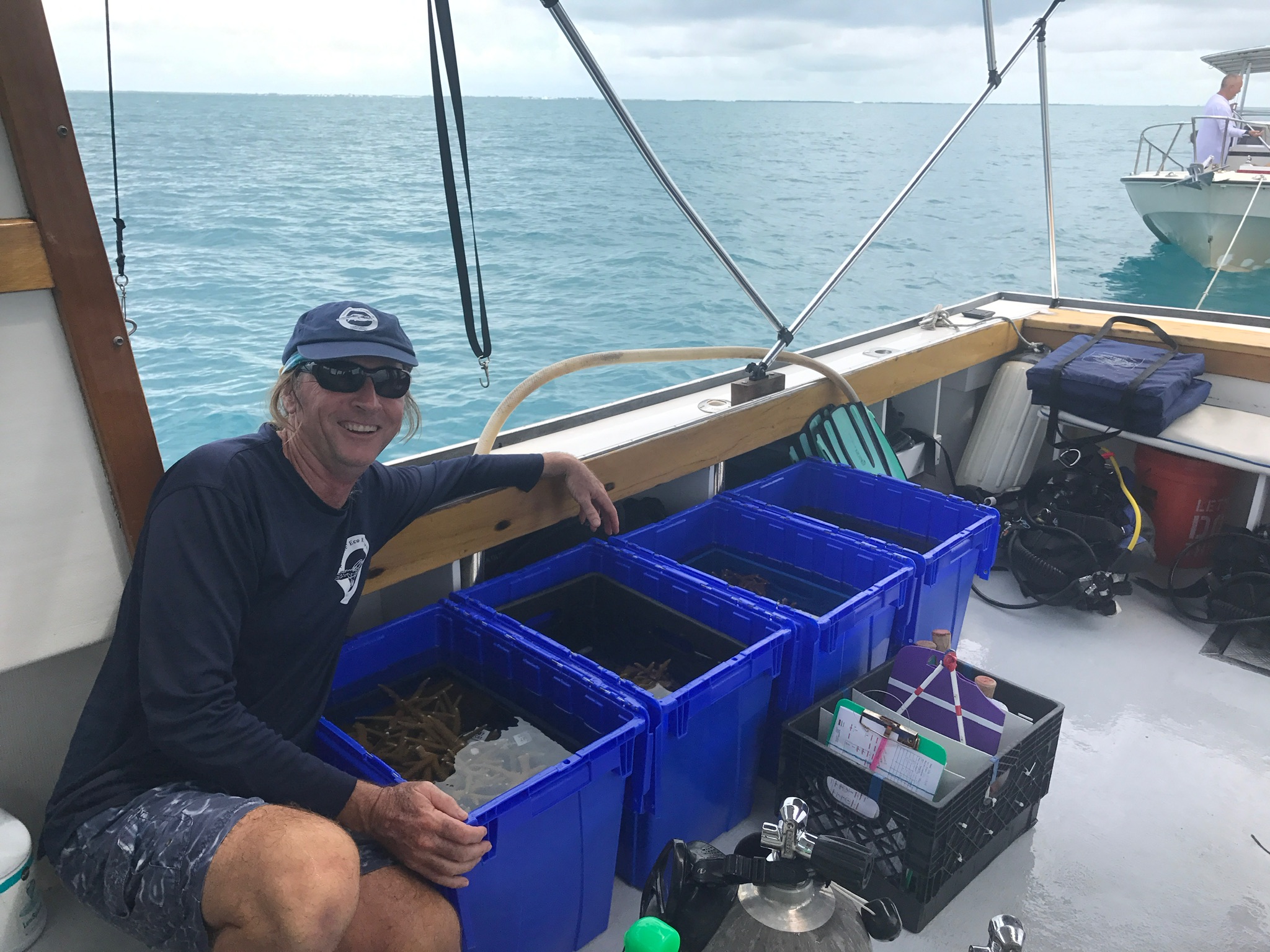
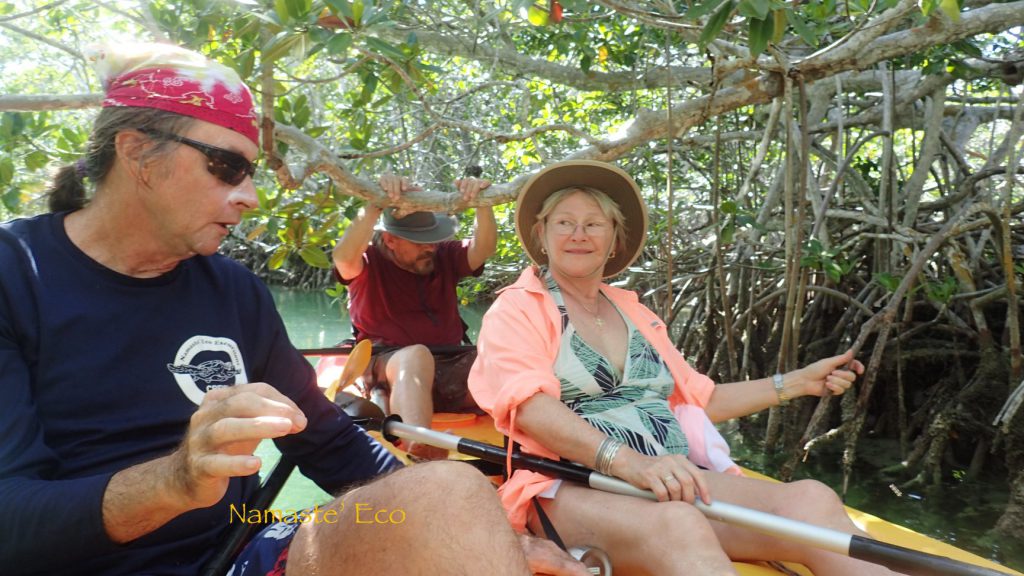
Pristine waters draw tourism. But too much tourism, in turn, can harm pristine waters. Over-tourism is a phenomenon when so many visitors descend on a destination that it harms that destination. The problem can extend to virtually every tourist activity, from the significant waste associated with the hospitality business to the ingredients in sunscreens that can be toxic to corals. Few tourist activities stir up controversy — or the waters — like the cruise ships that bring millions of passengers to fragile islands. Eco-tourism advocates like Bowman and Pleasant have been worrying about the vessels’ damage to Keys waters for years. The COVID-19 pandemic that emptied the Keys of the behemoth ships proved they were right.
Conchs to cruise ships
The southernmost tip of the country, Key West is a small island; only about 4 miles long and 2 miles wide. The city is home to about 23,000 residents, and its natives are called Conchs in honor of the iconic pink Queen Conch shell. Chickens roam freely, as do cats with abnormal numbers of toes. Old Town, Key West’s historic neighborhood, has a cozy, Victorian feel offset by its eclectic nightlife. The city is fun, funky and attractive to tourists. About three million of them a year were descending on the island by 2018.
One million of those came from cruise ships, which do not leave the waters unscathed. The arrival of the big, packed-to-the-brim tourist bearers decimates the bottom of the shallow channel they enter through—the same beautiful blue wonderland the cruises market on all their brochures.
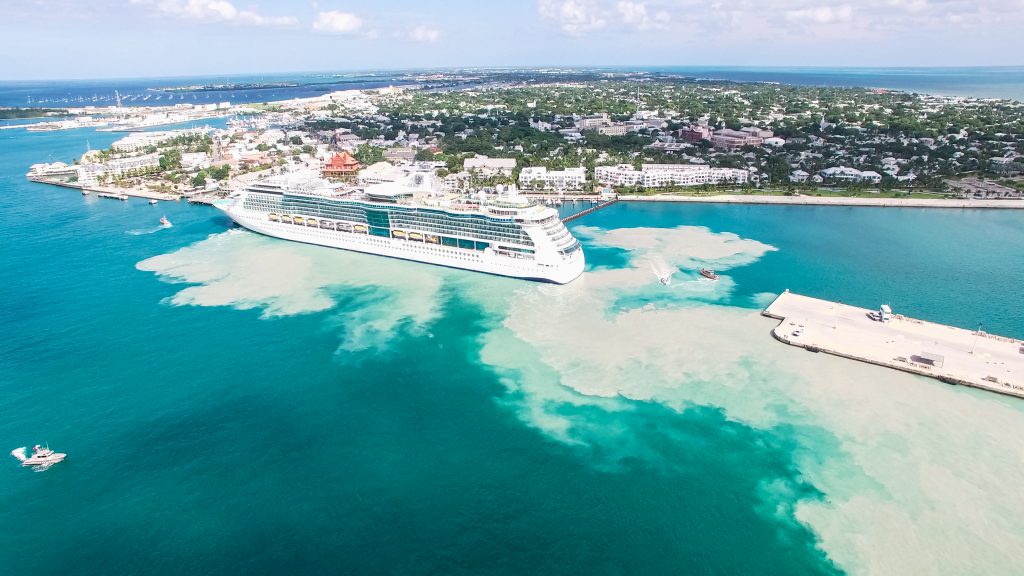
Arlo Haskell, a Key West native, writer and filmmaker, is one of four founders of the Key West Committee for Safer, Cleaner Ships, a grassroots movement that advocates for smaller cruise ships. He says the cruises riddle the channel with debris. The most damage is done to the bottom, which is stirred up and battered by the ships’ giant propellers. The resulting silt plume can flow for miles, like an underwater dust bowl. Haskell says the plumes smother the endangered corals, which are already threatened by rising sea temperatures. From above, the water looks like milk. On the floor of the channel, the cruise ships can leave giant cavities like craters on the moon.
On their tours, Bowman and Pleasant explain how the reef has changed, not because of a single threat but rather, “death by a thousand cuts.” They learned the concept from the Keys marine educator Alex Brylske, who taught that each cut, whether from cruise ships or overuse of the reef or pollution, may not be fatal on its own. But the force of them together threatens the nation’s last living barrier reef.
The major problem isn’t tourism, Bowman says, but excess tourism that includes mega cruise ships. As the COVID-19 pandemic spread across the world in 2020, Keys residents learned what their community would be like without it.
A moment of clarity
In October 2020, Key West’s streets were quiet. Non-residential traffic into the island was blocked. The sidewalks and shops normally filled with tourists were vacant. Cruise ships were given a no-sail order by the CDC.
The water started to clear. The halt in constant turbulence from above gave the channel a moment to breathe and to recover.
The island’s residents noticed first. The hazy silt clouds in the channel began to disperse. The gritty debris was noticeably absent — coral could be seen more clearly and dolphins didn’t flee in the big ship wakes. The cruises’ banishment began to look more like a reprieve.
Henry Briceño is a professor at Florida International University. He directs research in the university’s Water Quality Monitoring Network, which has worked with the Florida Keys National Marine Sanctuary to sample water quality for more than 25 years. The database provided Briceño an ideal way to study Key West’s water quality during the pandemic and compare it to former levels to determine if an improvement really took place.
The term Anthropocene, “the age of humans,” refers to the geological period during which human activity has become the dominant influence on the environment. Around the world, the pandemic slowed human activity enough to reveal what some scientists call the “Anthropause,” when waters cleared and animals returned to beaches and other areas. Briceño measured Key West’s water quality during this pause using three variables: turbidity, or how murky the water is; dissolved oxygen; and light penetration, which indicates how much sunlight reaches the ocean floor, where vegetation relies on it to grow.
Briceño’s findings showed that Key West residents were right: the water was clearer, at least on the surface. Turbidity was significantly lower in surface waters. Dissolved oxygen increased, and light penetration, while not statistically significant, had also changed for the better.
The dissolved oxygen increased despite a lowering of average temperatures, which normally would have lowered dissolved oxygen. This detail confirmed that something else — likely the pandemic — had caused the change.
Locals take a stand
In November 2020, a majority of Key West voters took a stand to keep their water as clean as it was during the no-sail order. They approved three ballot initiatives that would: limit the size and capacity of cruise ships allowed to dock at the island; limit the number of cruise ship tourists who could come ashore each day; and prioritize those cruise lines with the best environmental records.
Cruise lines have been under fire for their water quality records since the 1990s. Carnival Corp. paid its first large environmental fine in 2002 after a plea agreement in which the biggest cruise company in the world admitted to not only releasing oil waste into water, but falsifying records to cover it up. The corporation was charged $18 million and put on probation for five years. The company’s ships continued to violate pollution rules, including dumping plastic waste while on probation. Fines racked up to $60 million, less than 0.1% of Carnival’s profit.
The environmental NGO Friends of the Earth puts out a cruise ship report card each year. Few of the mega-cruise ship companies earn passing grades for the criteria, which include commitment to advanced sewage-treatment; reducing air pollution; complying with water-quality regulations; and whether the company is transparent in its environmental practices.
Yet within six months of local voters taking a stand against the largest cruise ships with poor environmental records, Florida Gov. Ron DeSantis signed a bill into law “prohibiting local ballot initiatives or referendum from restricting maritime commerce in the seaports of this state.” Part of a larger transportation bill sponsored by Sen. Ed Hooper, R-Palm Harbor, who chairs the Senate’s Commerce and Tourism Committee, the new law prohibits local government limits on any port “that has received or is eligible to apply for or receive state funding.”
Key West was able to restrict ships at two of its port’s piers–Mallory Square and the Navy’s Outer Mole Pier– but not at privately-owned Pier B, which leases waterfront from Florida. This summer, the state pushed further when it expanded the area of water that Pier B leases to accommodate cruise ships. Proponents of the ships point out that the Port of Key West that includes Pier B has an annual impact of $85 million each year, nearly 15% of the city’s tax revenue. It also provides 1,250 direct and indirect jobs to Key West residents, or 5% of total citizens.
The battle continues back and forth. Haskell said Safer, Cleaner Ships will continue working to limit cruise ships at Pier B. “It’s our golden egg,” Haskell says. “We can’t kill the goose.”
“Destination Management”
Would limiting cruise ships really solve the island’s water-quality issues? Briceño says that while cruises are the biggest tourism-related threat to the Keys’ fragile environment, they aren’t the only ones. Even tourist escapades like paddle-boarding and snorkeling — typical ecotourism offerings — can harm the reef and surrounding waters. With thousands of visitors wading into the water each year, the chemicals from their sunscreen alone can damage the corals. (When Key West banned local sales of sunscreens containing oxybenzone or octinoxate, suspected to harm corals, the Florida Legislature passed a law restricting such local bans.)
Visit Florida is the state’s destination marketing organization. The government-funded agency is the hub for Florida tourism information, which is used to calculate the state’s tourism development tax, or “bed” tax. The goal on Visit Florida’s website is for Florida to become the No. 1 travel destination in the world.
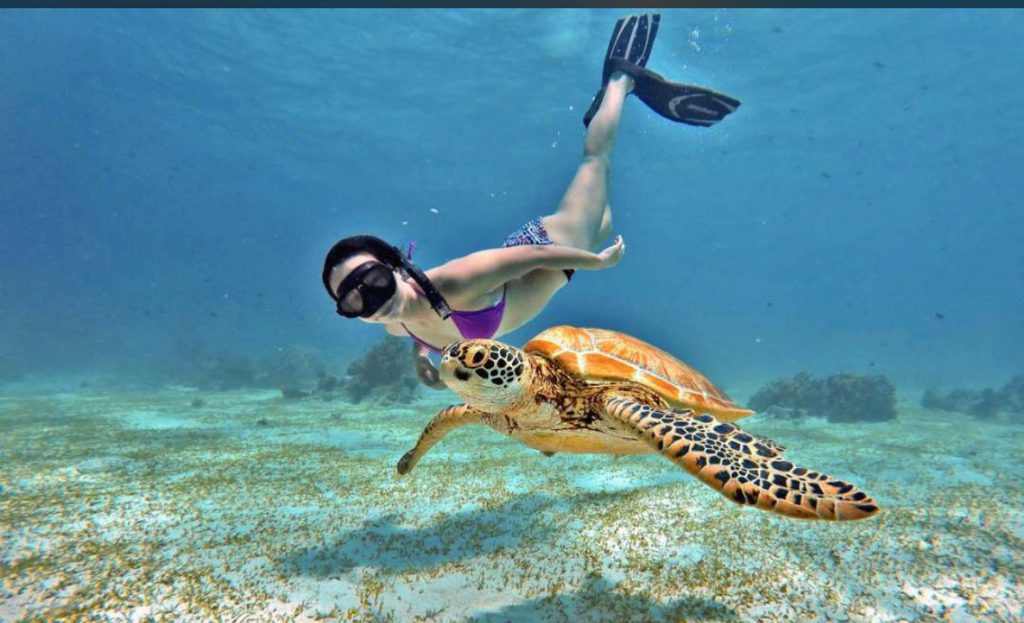
Orlando-based advertising agency Evok Advertising, which represents ecotourism businesses, found Visit Florida’s coverage of ethical, sustainable attractions like its clients — and those that weren’t theme parks — to be lacking.
Another criticism of Visit Florida is that it lures more people into the state than Florida’s fragile environment can accommodate. Florida native Chad Crawford hosts the TV series “How to Do Florida,” in which he shares all the ways residents can fall in love with their state. He also uses his platform to shed light on Florida’s environmental issues. Crawford says the state gets so hooked on out-of-state and international tourism that it ignores its own residents, which also bring value when they visit across Florida. He emphasizes that for out-of-state or international tourism to continue, Florida needs what it pitches: a pristine, beautiful environment. “We wanted to be the most traveled-to destination,” Crawford says. “It should have been, ‘We want to be the best’.”
The sustainability-focused anthropologist Brooke Hansen directs the University of South Florida’s Sustainable Tourism Program. She says while Florida has plenty of marketing plans for tourism, it lacks what is known as a “destination management plan” to help guide how tourism should operate efficiently and sustainably. Students in her classes study global models — including tourism plans that work, and those that don’t — to ponder what kind of plan might work in Florida. Who would manage it? Visit Florida? The Florida Department of Environmental Protection? How would it be organized? By county?
The choices are not 100% clear, but there are notable examples elsewhere, including Hawaii, another state that thrives on tourism. Hansen studied Hawaii’s plan to manage travel in ways that recognize the environment, the economy and its indigenous people. . The plan sets out to ensure that tourism benefits Hawaii’s communities and people more than it burdens them. The plan’s annual survey of Hawaii residents shows that people generally think tourism is worth it, though they continue to feel that visitors are contributing to environmental damage, overcrowding and other problems.
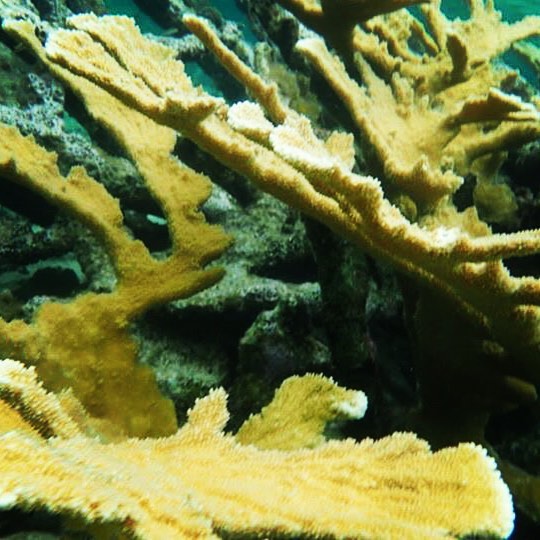
Hansen says Florida’s current tourism patterns are unsustainable because the number of people being lured to the state threatens to overwhelm the amenities they want to visit. It’s a lose-lose situation: If the scores of visitors drain Florida’s natural assets, tourism profits will shrivel up, too.
David Randle is a co-founder and managing director of the Blue Community Consortium, a program that seeks to unite coastal communities around sustainable tourism and habitat protection. Key West and other coastal communities shouldn’t have to choose between economic and environmental well-being, says Randle, who also serves on the board of directors for the Florida Society of Ethical Ecotourism. Doing the right thing, he says, can also produce better profitability for local tourism businesses.
Blue Community developed 12 sustainable tourism strategies in partnership with Disney’s Animals, Science and Environment team, which saved the company $35 million a year in Florida. The example shows how intention, from mass transportation to reduced use of plastic and promotion of local foods, could benefit Florida and other tourism-dependent economies in the long run.
Back at Namaste’ Eco-Excursions, Bowman and Pleasant continue to emphasize citizen science and reef-friendly products despite the forces of mass tourism pressing around them. They share promising stories like the Plant a Million Corals Foundation, marine scientist David Vaughan’s efforts to reproduce fast-growing corals to restore lost reefs.
Bowman’s fond image of the underwater forest he saw 55 years ago has the hazy edges of a dream. But it is the picture of Key West waters he wants his kids and all future generations to enjoy. The golden reef is Florida’s golden egg; another fairy tale to be illustrated in his book, shared with visitors for years to come.
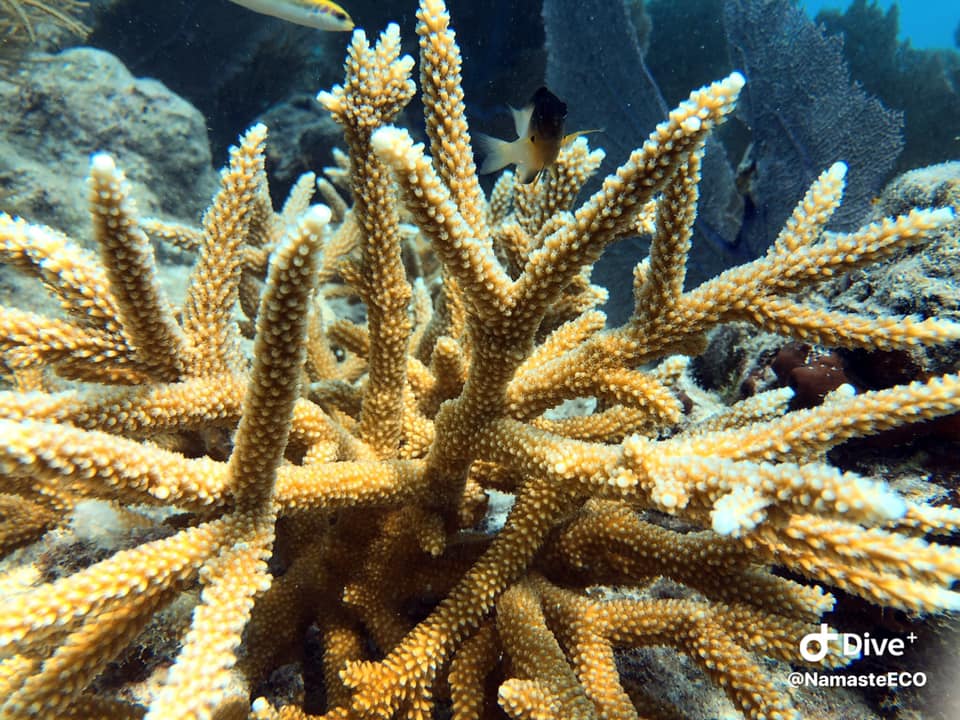
This story is part of the UF College of Journalism and Communications’ series WATERSHED, an investigation into statewide water quality marking the 50th anniversary of the Clean Water Act, supported by Pulitzer Center’s nationwide Connected Coastlines reporting initiative.
 WATERSHED
WATERSHED